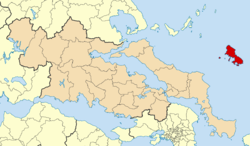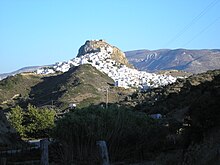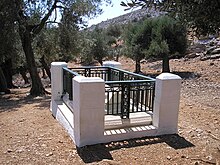Skyros
|
Skyros municipality Δήμος Σκύρου |
||
|---|---|---|
|
|
||
| Basic data | ||
| State : |
|
|
| Region : | Central Greece | |
| Regional District : | Euboea | |
| Geographic coordinates : | 38 ° 54 ' N , 24 ° 21' E | |
| Area : | 223,100 km² | |
| Residents : | 2,994 (2011) | |
| Population density : | 13.4 inhabitants / km² | |
| Community logo: | ||
| Seat: | Skyros (Chora) | |
| LAU-1 code no .: | ||
| Districts : | no | |
| Local self-government : | no | |
| Website: | www.skyros.gr | |
| Location in the Central Greece region | ||
Skyros ( Greek Σκύρος ( f. Sg. ), Pronunciation : [ ˈskʲirɔs ]) is a Greek island in the Aegean Sea that belongs to the Northern Sporades .
geography
With an area of 208 km², the island, 25 nautical miles east of Evia , is the largest of this group of islands. At the same time Skyros forms a municipality (δήμος) in the region of Central Greece .
Skyros is bordered by numerous small islands, especially in the west - Valaxa and Skyropoula ('little Skyros') are worth mentioning . There are lighthouses on the islets of Notios Podies and Voreios Podies off the north coast.
While the southern part of the island is mountainous, barren, stony and uninhabited, the approximately equally large northern part, in which almost all islanders live, is characterized by lush vegetation and large Aleppo pine forests. The highest point on the island is 792 m above sea level. d. M. Mount Kochylas.
places
- The main town of the island, the village of Skyros with 1657 inhabitants, also called Chora .
- The port of Linaria ( Greek Λιναριά , 116 inhabitants).
- The small village Atsitsa ( Greek Ατσίτσα , 13 inhabitants) in the northwest, location of an esoteric center Atsitsa Center.
- With the places Acherounes ( Greek Αχερούνες , 65 inhabitants), Aspous ( Greek Ασπούς , 107 inhabitants) Magazia ( Greek Μαγαζιά ) and Molos ( Greek Μόλος , 618 inhabitants) there are further settlements, but these are only collections of holiday homes and taverns mainly at the Beaches of the island are.
history
A settlement of the island as early as the Mesolithic is proven by hand ax finds. In the Neolithic , from which remains of several coastal settlements can be found, Skyros seems to have been a stopover for the obsidian trade from Milos to the northern Aegean, as evidenced by numerous obsidian finds .
Skyros plays a role in the legend of Achilles and Theseus : Theseus is said to have lived here after his expulsion from Athens and to have died through Lykomedes . The island's economic importance was low in antiquity. Originally inhabited by Pelasgians and Carians , then by pirate Dolopers , Skyros was inhabited around 475 BC. Conquered by the Athenians under Kimon , who brought Theseus' bones from there. Since then it has been in Athenian ownership for several centuries, with few interruptions. In ancient times , Skyros was considered poor, stony and sterile, but it had beautiful, brightly colored brecian marble , which was very popular in Rome, chrome iron ore and a famous breed of goat.
In the Middle Ages, Skyros was 'pirate booty' - that's why the main town is built on the part of the rock facing the island core. You couldn't see the village like this from the sea. In 1207, when the Byzantine Empire was divided up after the Fourth Crusade , the island fell to the Venetian noble family of Ghisi, along with Skiathos and Skopelos . In 1269 Emperor Michael VIII Paleologos regained it for Byzantium, which it gave as a fief. The Duke of Naxos , Nikolaos Carcerio , who fled to Skyros in 1354 , expanded the castle over the Chora .
After the fall of Constantinople in 1453, Venice succeeded again in taking possession of the island. With the conquest by Khair ad-Din Barbarossa , the Turkish rule began (1537-1829). The Greek islanders were resettled to Corfu on the Venetian initiative in 1645 , after which Skyros was repopulated by immigrants from the Thracian region.
Attractions
The Chora is considered to be one of the most beautiful villages in the Aegean. The townscape with narrow and steep alleys and stairs is reminiscent of a Cycladic village. The place is built like a terrace around a conical rock, so that cars only drive as far as the edge of the town center.
The main church of Panagia Melikarou has a hand-carved iconostasis decorated with gold ornaments with numerous icons . In the middle of the wooden ceiling there is a pantocrator representation.
An ancient acropolis was enthroned on the steep granite rock above the town as early as the 4th century BC . The Kastro , the castle-like fortification, was originally built in its current appearance in the Byzantine period, expanded and completed after being destroyed at the end of the 14th century. The imposing thick walls, sloping almost vertically towards the sea towards the east, offered good protection from pirates.
On the way to the castle rock is the monastery of Agios Georgios Skyrianos, the patron saint of the islands and the national saint of Greece. Its original building was erected in 895. It is entered via an idyllic cloister courtyard with a cistern, antique column drums, millstones, clay pots and a cypress. The monastery church, a four-pillar structure dating from 963 but destroyed several times by earthquakes, has a splendidly gilded iconostasis with numerous icons and some preserved frescoes.
After an earthquake in spring 2001, the monastery and fort are being renovated (not yet completed in early 2013) and are closed to visitors. The monks now live in a George monastery in Magazia.
In addition to a number of other churches and chapels that are well worth seeing, the Chora has an archaeological museum and the private Faltaits Museum with exhibits from folk art that are well worth seeing.
The English poet Rupert Brooke (1887–1915) died as a naval officer on a hospital ship off Skyros of malaria and found his final resting place in the south of the island in the bay “Tris Boukes”. His marble grave in the middle of an olive grove is still looked after and maintained today. The philhellenic , whose patriotic poems are well-known in England, was erected in 1931 in one of the most beautiful places on the island above the Chora, a bronze statue by the sculptor Michalis Tombros , which, however, depicts the poet undressed and therefore displeases the clergy: during services in the neighboring church and on important religious holidays the nakedness is therefore veiled.
regional customs
The old folk costumes have long been preserved on Skyros. Today, however, they are seldom seen at church festivals, weddings and carnivals .
Carnival customs are ancient and mystical: frightening figures with hooded goat hair jackets - the so-called "Iéri" (singular ο γέρος) - roam the streets with noise and din. They have dozens of heavy goat bells strapped on, which they make rhythmically rattle by dancing and jumping. The traditional costume (both of the "Iéri" and of men in general) includes the typical sandals made of skyros ("trochadia"), the soles of which are made from old car or motorcycle tires.
The houses in the Chora are often still traditionally designed and furnished. Chests and low chairs are decorated with wood carvings. In the living room ceramic and porcelain plates, copper dishes and other decorative household items are lined up on ledges and shelves around the fireplace.
Skyros marble
Skyros has been known for its numerous types of marble since ancient times . In ancient times, the Scyreticum marble was mined in the varieties Breccia di Settebasi (dark red to light red breccia) and Breccia a samesanto (purple to brown). Well-known examples that still exist are the Hadrans Library in Athens and the St. Demetrius Basilica in Thessaloniki. Since the 19th century, Skyros marble has been used as a luxurious building material, for example in the Woolworth Building in New York, in the Palacio San Miguel in Buenos Aires and in numerous London banks.
military
Skyros has a key position for the military . A military airfield and a naval base are located there. There are several extensive military restricted areas on the island.
Military airfield
The military airfield ( IATA : SKU , ICAO : LGSY ) was opened in 1978 and has also been used civilly since 1984. The paved runway with an orientation of 17/35 is 3.002 m long. The military airfield is 13 m (44 ft) above sea level . Aegean Airlines from Athens and Sky Express from Thessaloniki fly to the airport several times a week .
![]()
Others
The semi-wild Skyros pony can only be found on the island. With a shoulder height of max. 110 cm, it is the favorite of island children and tourists. Since it is now threatened with extinction, there has been a Soste to Skyros Pony campaign 'Save the Skyros Pony' since 2004 .
Web links
Individual evidence
- ↑ Results of the 2011 census at the National Statistical Service of Greece (ΕΛ.ΣΤΑΤ) ( Memento from June 27, 2015 in the Internet Archive ) (Excel document, 2.6 MB)
- ↑ Arne Strid, Kit Tan (Ed.): Flora Hellenica. Volume 1: Gymnospermae to Caryophyllaceae. Koeltz Scientific Books, Königstein 1997, map 9.
- ^ Wolfgang Günther: Skyros. In: Siegfried Lauffer (Ed.): Greece. Lexicon of Historic Places. CH Beck, Munich 1989, p. 626 f.





